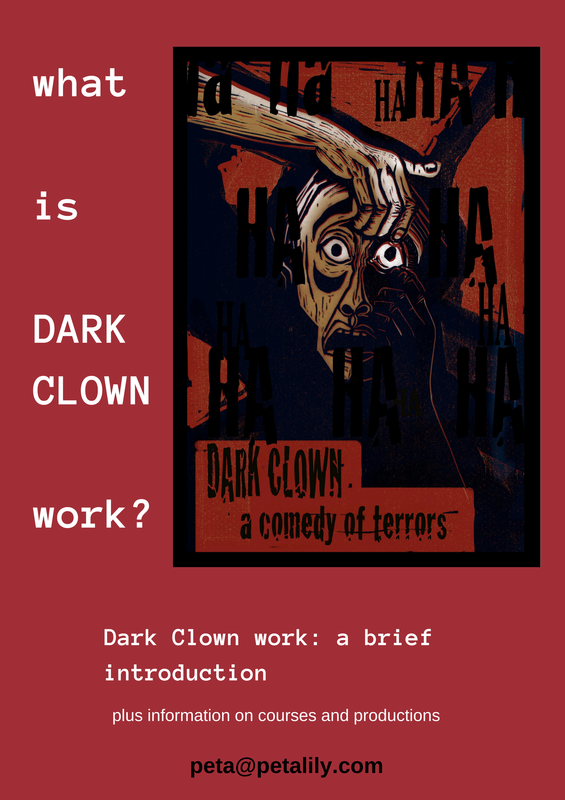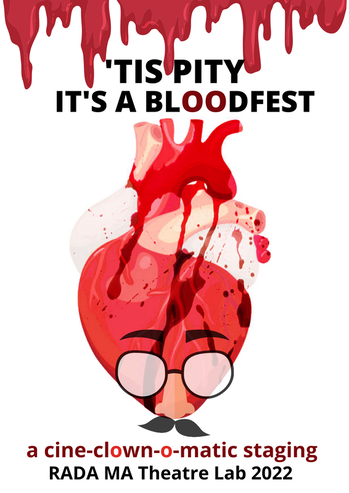
What makes a great story?
Chorus lean in eagerly.
All great stories must deal with blood, (le sang) sperm (sperm), and tears (des larmes).
- Gaspar Noé / The No Way Brothers
Content alert: knee-jerk violence and the ever-ongoing oppression by those in power. Mention of body fluids.
Summer 2022 - the latest ''Tis Pity She's A Whore' clown play adaptation. The third iteration of 'Tis Pity - but (because of Covid-19) the FIRST one to be seen before an audience.
This post is a tad long – apologies. The start looks at the process including useful communications and framing for the process.
You can scroll down to find more jokes!
Preproduction
As mentioned earlier I have a process for creating clown adaptations for a classical text. This is on RADA’s MA Theatre Lab – dedicated to develop theatre-makers. (When we worked The Revenger's Tragedy, the student cohort would be tasked with drawing a storyboard for the play (stickmen or geometric shapes for the characters are fine!). Also some years I asked them to draw a family tree to get fully acquainted with the complex relations in TRT. The text of ‘Tis Pity reads much more easily and the family tree is not so complex so we skipped this step)
Skills and Clown Council
Clowns bring their skills to create magic as well as laughter (the superb clown Tweedy has an astonishing level of horsemanship - among other skills). We set aside time to make a collection of people’s skills: Singing, Martial arts, the ability to crush a watermelon between one’s thighs (!) … all was noted down.
As described in a previous post, the clowns discuss the themes and give their responses to the play in the Clown Council process. This year one clown stood up and said: 'I wonder how they got the heart out of the body?'. The clown's direct, simple curiosity added a clarity of overlooked detail to an already shocking event. Now we can't help thinking - at what point did Giovanni prise his sister's ribcage apart?
Process questions
We had had one discussion of the play where it started to spin off into issues and ideas. Our work would be built beat by beat, so I like to help people think concretely. Ideas need to be grounded in detail – what are the audience actually going to see? Character is plot and plot is character. And Clown Dramaturgy is where jokes meet heart (I haven't fully articulated this as a theory, but it's intuitively sound and at least kinda pithy).
The cohort were set 4 homework questions:
1/ What is your potential interest as a performer for our Clown adaptation of ‘Tis Pity?
For example: ‘I want to explore stillness’, ‘I would find a rewarding challenge in playing a tragic scene’. Are you interested in speaking classical text? Are there monologues from other plays that might make a point (e.g. a student in a previous year brought Wilde’s Salome’s love/hate speech for Hippolita). Or are you interested in Mime performance? What scene might you enact using Mime?
2/ Regardless of any gender expression, what is a character role you are interested in? And what character would be a stretch/challenge for you as performer? Feel free to include ‘lesser’ characters from the play. Clown world is open to the overlooked perspective. There is also the possibility of playing a character from the conceptual ‘world’ – see #3. Also there can be Clowns who play representational roles e.g. the clown who played Vengeance in one TRT production and who literally stopped the show for an entire minute, to great hilarity.
3/ Think about the possible ‘world’ for the adapted piece (or one of the chapters -might we have a different world for each ‘chapter’?
By this I mean what is the ‘game’ – i.e. why are the clowns doing the show for the Sad Normals*? What kind of troupe are they? Are they a troupe? Or are they strangers to each other (reflections of today’s algorithm-divided world) …
Depending on the world we agree upon (I will play a role as guide and arbiter in our process), there are potential roles of interrupter, stage manager, Footnote Clown, lecturer (e.g. on the subject of women’s anatomy, perhaps).
It could be 4 (or 5) distinct pieces focusing on different themes with a character/pair of clowns who link/s the presentation …?
4/ What scene or event from the play intuitively fascinates you – what is it about that which fascinates you?
The ‘game’ with the audience
Looking over the responses to these four questions enables me to see the commonalities. A number of students mentioned a film set as the location and game for the show.
Brilliant – the situation is that this is a rare (unique?) event: a live-before-a-studio-audience making of a film. In the opening this would be clearly set up, so that the fourth wall was eradicated. Also because Clarity is one of the prime useful ingredients of comedy**.
A Cardboard Camera
Props maketh the world – in any production, you need to ensure the materiality of the production supports your aesthetic/ concept. In any student production (or low-budget show), you need to know you can realise the concept. (e.g. Will the budget allow for a stunning red tapestry to lay before Agamemnon’s feet? No? Is that piece of red cloth really cutting it? Might the carpet be represented with lighting? Are there other moments in the piece can lighting play a graphic, non-naturalistic role? Can this be your aesthetic? No lighting? So can you use the ensemble to all draw apart with awe, like something stretching apart, like the Red Sea parting, with a music cue or a vocal sound of dread and awe?). A student made a cardboard camera and boom mike. These objects added exquisite focus in more than one scene. An actual clapperboard was provided, which was a godsend – a cardboard clapperboard would have fit the visual bill, but would not provide the iconic percussive sound needed to kickstart/frame a scene. I ask for students who enjoy make or who are willing to make props. An artistic student put herself forward and I asked for a large anatomical heart to be made. ‘Can’t it be like a cartoon heart?’, she asked. Yes, I said, but can you make it so that it has an anatomical feeling - have some arteries coming out of it – as this will better serve the visceral horror a the heart of the story. The final object was beautiful - a big, rounded heart, with the amputated toilet-roll arteries sticking out.
Happenstance
I had just listened to a podcast with maverick film maker Gaspar Noé. His extreme, eclectic style encompasses violence and sexuality in a way that is a lovely Contrast to the sweetness of the clown. At the core of the play is the physical love – the physical taboo love of the brother and sister and the high level of abandonment to risk-taking. I thought the spirit of the opening dance scene of Noé’s film Climax was a model for an expression of erotic energy/urgency, which we had visited in the studio in a danced improvisation on that subject (people ranged in two rows, no touching permitted – aim of the improv and consent to do the exploration checked and the possibility of anyone having the right to elect to leave the improv etc - all discussed in advance).
The skeleton and the heart
As a group we check in and gather agreement. I then emailed the group saying:
We are now in agreement on the idea of the Film Set for our Clown adaptation of ‘Tis Pity. (Thank you for your flexibility and generosity, those whose concepts were not chosen). The Film Set allows for a possible switch back and forth of the timeline, should that be needed.
Commedia dell’Arte master Carlo Boso used to talk about having a ‘skeleton’ (i.e. a rough draft) for a show shape/plot. At this starting point, I can see where some of your suggestions might hang ... other suggestions and contributions are still waiting to find their place. Please may I have your willingness to be flexible and patient with me and the process. Please forgive me if I have mentioned some people more or less than others. I'll keep checking in with everyone, and please do let me know if you have any thoughts or concerns, or if you want to remind me of anything you think would be useful. Write your ideas down – I may say no to something first then later see possibility for it – it’s dependent on themes being woven / pieces falling into place.
I will be aiming for the piece to allow us to be invested in the heart of the story which is the weird plight of being human and the plight of the disempowered (as exemplified in Annabella’s difficult predicament).
Please know that this will be an ensemble piece and in my experience all performers will be well seen. All of you will be onstage throughout (sat at the sides when not in the central stage action – there are often little playing moments, details or choral action for those who are visible, in clown state, at the sides of the stage).
We need to make a show that is not over an hour (max 1 hour 10) – this is in order to
a/ allow it to work as a clown performance with taut energy and b/ also to allow us to prepare it rehearsal-wise in the tight time allotted to us.
I will aim for everyone to shine but cannot guarantee a meticulously equal distribution of roles / centre stage action. Please do help me with positive suggestions – in the past people have said things like: ‘actually I am doing this and that and perhaps someone else can take this part of what I was initially offered.’ Some roles may crystalize later than others.
Any making process will bring change and edits (things may be cut) – please be aware this may happen – again, please do offer me
your suggestions
and also
your flexibility, resourcefulness, and patience.
Any concerns - just come and speak to me or email me – forgive me if I don’t have an answer / solution straight away.
Those who mentioned Giovanni, please select and learn your favourite lines / stage directions / devised-physical-score-iteration-of-a-moment in Giovanni’s journey or inner life for the Big Giovanni Audition (which will be a scene in our show).
This process allows you to witness a making / assembling process. It is not the only process, but it is a process you can later examine as you define and refine your own methodologies. See the document attached – it is a ROUGH DRAFT.
I added columns to the right because I find it useful to think of the function of each scene, so you can get a suggestion of a thinking / planning process.
(Later, when working in the room, I find it useful to clarify the beats within the scenes, too).
Be aware and flexible - some moments of our process will include improvisation and then there will be moments of precise direction. (Often people get the hang of this building of beats and can start to work with it themselves).
Regarding the attached rough draft, please know:
The first scenes are in place but the scenes that follow are ingredients, not yet ordered– the order will reveal itself (it may correlate to the chronology of the play or not). I will be looking to have changes in tone and energy from scene to scene.
Listed scenes that seem on the page like they might be solo pieces, may well have other performers involved.
Some scenes will need an introduction / framing / explanation - we have an appointed audience liason character, but it might not always be this clown that provides this – it might be a ‘make-up artist’ clown or the boom-holder clown or the clapperboard clown or another actor who does that in a given moment. Clowns may have multiple functions / roles – so long as that is not confusing. The reality of the film set needs to be preserved and followed through but not where it may hold up the action.
Hanging the flesh on the ‘skeleton’ (phrase from Carlo Boso)
The ingredients accumulate around the theme and concept .
As we worked the starting group scene, clowns found their film set activities: focus puller, social media person, stunt practitioners, waiting actors, production team.
Jokes are the building blocks of Clown dramaturgy
There would be a kind of PSA on Incest. And there would be a moment where a clown dressed as cupid would outline (using martial arts) the seven different kinds of love (as defined by the Greeks). There were ingredients from previous years that were recyclable. The as-yet-unperformed Salome speech. A ‘splitscreen’ scene where marriage, love and death are juxtaposed and counterpointed. The as-yet-unperformed soliloquy by the unborn issue of Giovanni and Annabella.
Two clowns would play the enfant terrible film directors, the ‘No Way’ brothers: Gaspar and No Way. It's in part a nod to the Cohen Bros and the Watchowskis. Doubled roles are useful in ensemble productions to maximise access and to keep playing-time and featured events concise, but their siblinghood actually allowed for an added embarrassed amplification of the incest theme. In clown dramaturgy, running gags can uphold and underscore theme.
One student elected to play the ‘Great Actor’ and had a personal assistant.
Another brought the beautiful contribution of being an Intimacy Coach:
Hello, I’m Crysanthemum Garcia, Intimacy Coach with a speciality in Incest.
And in case anyone in the audience here tonight is involved with their sibling – we welcome you!
One student added a beautiful Queer perspective as the Friar. Giovanni is tormented by his love for Annabella and the forbiddenness of it. The Friar experiences an equal or greater agony at counselling Giovanni to deny his love and desire – tormented all the while by his own feelings for Giovanni.
He delivers a poignant yet show-biz fragment of the Pet Shop Boys song It’s a Sin.
Two students who wanted to stretch themselves to play calm sweetness together portrayed Annabella, wearing blue pyjamas, and delivering a speech from Emilia:
‘My voice is too loud in here. I must try to whisper more.’
The role of Putana - a flawed but affectionate woman – was played with a hat-tip to a panto dame who delivers a rap on her entrance:
Yo – my name is Putana,
Here is my Katana,
Nursemaid to Annabella in the beautiful city of Parma!
… and who later meets a disproportionately cruel punishment.
One clown plays a kind of live-audience warm-up man – with incest jokes:
My sister hates it when I invade her privacy. hands together Jimmy-Carr-style in front of chest
It's written clearly right here in her diary. open hands as book
Knock knock face right
Who’s there? jump face left
Your brother. face right
Come on in and lock the door behind you. centre
I used text lifted verbatim from an interview with Gaspar Noé as the No Way Brothers are being interviewed:
What makes a great story?
The whole chorus lean in
All great stories must deal with blood, (le sang) sperm (sperm), and tears (et des larmes).
The interviewer clown hesitantly asks:
(bounce bounce, intake of breath) As brothers, what’s it like making a film about micropause incest?
The No Way Brothers look at each other for 4 beats, then stand and, hiding their unsettled feeling, ebulliently wave the suggestion off.
What? no. We are brothers, but no, no incest.
Following the rules of clown chaos, and emulating the spontaneity of the film auteur, there is an audition midway through. The Brothers return from an absence on stage up the central aisle of the audience, announcing: ‘Giovanni, Giovanni.’ – they face the audience centre.
No Way: We have a very organic process,
Gaspard: The camera is the lover. The camera is a murderer, it kisses, it kills.
No Way: Le tout c’est de créer dans une diagonale qui se positionne entre le submersif, le subversif, l’irreversible. You see ?
Et maintenant, on incarne Giovanni.
Three would-be Giovannis perform their monologues (one is delivered in Hindi). There is an intrusive amount of scrutiny by the No Way brothers and the carboard camera and the predatory, hanging boom. The brothers feverishly frame the shots – they lay on the floor between one actor’s legs – they climb on each others’ shoulders to tower over another. A visual depiction of the discomfort some actors experience in the world of film. This is the joy of clown work. In one way this scene is a celebration of the untrammelled creativity of the loveable No Way Brothers, but it’s also a metaphoric echo of the established regime’s control over people – Vasques forces the truth out of Putana and punishes her for not reporting the siblings.
A Binoche-like Hippolita storms onto the set and out-Diva’s the Great Actor with her Salome speech of lust and hatred doctored to deliver a socially responsible ecological message:
Thy hair is like the great cedars of Lebanon that give their shade to the lions - rawwrr! (claws on his back) - before they were poached and used as living room decoration. Thy black hair is as beautiful as the night, as black as the silence that dwells in the deep forest, before it was chopped down by IKEA ... Let me touch thy hair.
The maiden Philotis speaks to the Brothers:
This film isn’t only about Giovanni and Annabella, and Soranzo and Hippolita.
My character, Philotis – is about to marry and yet will remain forever unwed.
The machinations and violence of Annabel’s suitors rob me of my beloved Bergetto
Bergetto: Haha that’s me !
Philotis: … and so, I shall hereafter need
to get me to a nunnery.
You see,
there are other stories that have blood and tears,
but which don’t have the luxury of sperm.
The comic principle of re-incorporation allows also for a poignancy and a development of thematic thread of power and oppression.
Finally, we reach the scene of all the deaths (prefigured at the very start of the show).
The unborn child appears and delivers a speech ending with:
Murdered. Unborn.
by my uncledad’s blade.
Was ever nephewson afflicted thus!
The maidenly Philotis sits and places a watermelon between her thighs, shouts: Death to the Patriarchy!
It breaks into glorious wet red - like blood, like a birth or a gynaecological procedure gone wrong.
Brothers: What was that?
Philotis: A symbolic act. This is the melon in the plot that the Doctor says is the cause of Annabella’s stomach-ache – when really, she was pregnant … the melon is the TRUTH!
And the sad truth is that Annabella receives the title slur of the original play text – as if she were to blame for the bloodshed hotly meted out by other characters.
The production assistant / audience greeting clown comes quickly (stepping over bodies):
Er, Gaspar? No Way?
No Way Bros: Oui. Yes?
Helen: The audience need to go home.
No Way Bros: Oh. (look at audience) Did we cover everything?
Helen (flips though script): … Er … No.
No Way Bros: No. But it was beautiful!
Character is plot.
Plot is character and action. Blood is plot and Sperm is plot. Tears are plot. The extraneous is subcutaneous, the negligible is the indelible.
We put sound and images together that have never been put together before.
It’s like a man jumping off the Pont Neuf and never reaching the water.***
It’s over. It’s not over. ... It’s perfect!
It’s a wrap everybody!!
Bodies start to clear but Putana is still sightless centre back.
But, in the true manner of comedy, we added a song and a reconciliation, in the mood of a Wrap Party.
.....
* Sad Normals - a phrase I use when teaching clowning. ‘It’s the clown’s job to show all the thought processes, failures and feelings the Sad Normals (me in the supermarket) would prefer to suppress and hide.’
** A handy guideline – as ever, I acknowledge ‘there is the rule and there is the breaking of the rule’.
*** at the beginning in the interview the Brothers quote Noé.
Interviewer clown leans in to the two clown brothers.
No Way: We are kind of unique, and kind of twisted.
Gaspar: Psychedelic, cerebral, chaotic, gut-wrenching, nihilistic – and fun.
No Way: We were inspirated by experimental movies – Kenneth Anger …
Gaspar: …and witchcraft
Both: When we were 16 we shot a Super 8 of our best friend jumping from the Pont Neuf bridge.
No Way: It was our first psychological drama. (said with action of sitting)
No Way: You ask what makes a great film? Chorus moment When you meet images and sounds that you haven’t experienced before.
Gaspar: What makes a great story? Chorus moment All great stories must deal with blood ...
No Way: le sang
Gaspar: sperm
No Way: sperm
Gaspar: and tears
No Way: ... et des larmes.
Adapted from this interview.
If you'd like to support the blog - or to help make possible the writing of the Dark Clown book - go here.
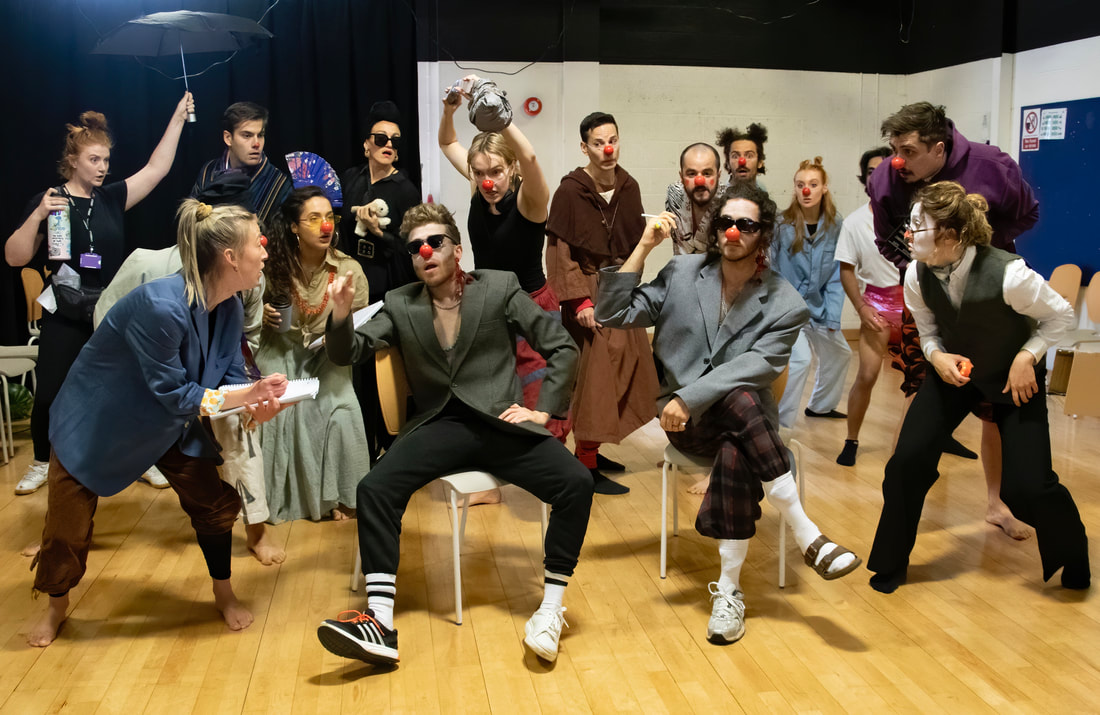
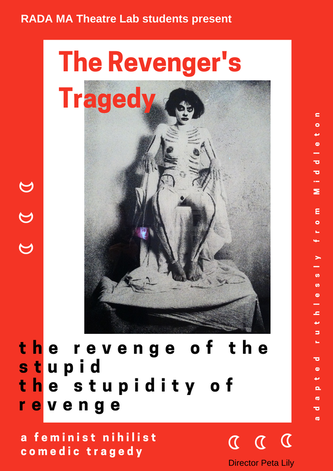
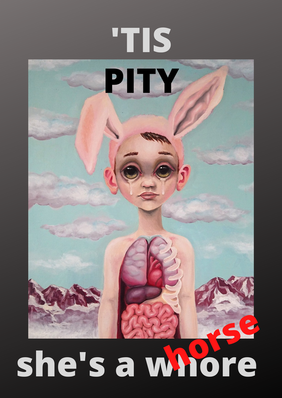
 RSS Feed
RSS Feed
